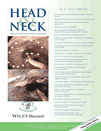Elevated levels of 1-hydroxypyrene and N′-nitrosonornicotine in smokers with head and neck cancer: A matched control study†
This publication was supported by Grant Number 1UL1RR033183 from the National Center for Research Resources (NCRR) of the National Institutes of Health (NIH) to the University of Minnesota Clinical and Translational Science Institute (CTSI). Its contents are soley the responsibility of the authors and do not necessarily represent the official views of the CTSI or the NIH. The University of Minnesota CTSI is part of a national Clinical and Translational Science Award (CTSA) consortium created to accelerate laboratory discoveries into treatments for patients.
Abstract
Background
Head and neck squamous cell carcinoma (HNSCC) is associated with tobacco use. Still, most smokers do not develop HNSCC. The mechanisms of varying susceptibility to HNSCC are poorly studied to date. Tobacco metabolite research provides insight regarding the innate metabolism and excretion of carcinogens.
Methods
Smokers with HNSCC (cases) were compared with smokers without HNSCC (controls) in a matched cohort. The tobacco metabolites studied were: 1-hydroxypyrene (1-HOP), N′-nitrosonornicotine (NNN), and 4-(methylnitrosamino)-1-(3-pyridyl)-1-butanol (NNAL).
Results
In 33 subjects, mean 1-HOP was 1.82 pmol/mg creatinine versus 1.08 pmol/mg creatinine (p = .004) and mean NNN was 0.10 pmol/mg creatinine versus 0.04 pmol/mg creatinine (p = .01) in cases and controls, respectively. NNAL did not differ between groups.
Conclusions
Smokers with HNSCC have elevated urinary levels of 1-HOP and total NNN compared with matched controls, suggesting an increased effective exposure to these carcinogens. Tobacco constituent metabolites may be useful in understanding tobacco-related carcinogenesis in HNSCC. © 2012 Wiley Periodicals, Inc. Head Neck, 2013




